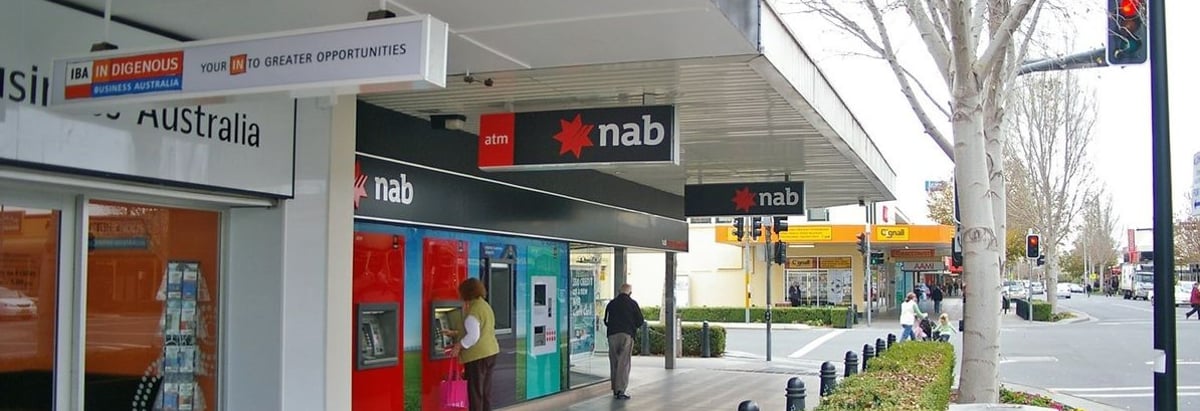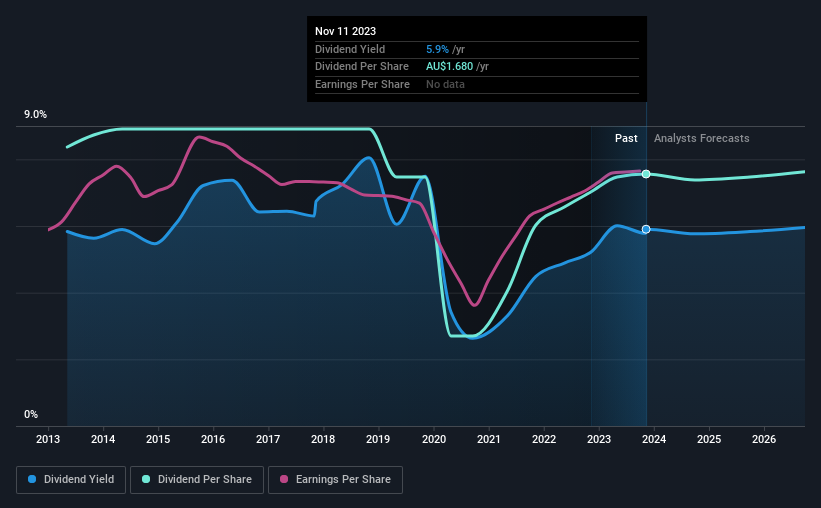National Australia Bank (ASX:NAB) Will Pay A Larger Dividend Than Last Year At A$0.84

National Australia Bank Limited (ASX:NAB) has announced that it will be increasing its dividend from last year's comparable payment on the 15th of December to A$0.84. This makes the dividend yield about the same as the industry average at 5.9%.
See our latest analysis for National Australia Bank
National Australia Bank's Dividend Forecasted To Be Well Covered By Earnings
While it is always good to see a solid dividend yield, we should also consider whether the payment is feasible.
National Australia Bank has a long history of paying out dividends, with its current track record at a minimum of 10 years. Taking data from its last earnings report, calculating for the company's payout ratio shows 70%, which means that National Australia Bank would be able to pay its last dividend without pressure on the balance sheet.
The next 3 years are set to see EPS grow by 0.3%. The future payout ratio could be 73% over that time period, according to analyst estimates, which is a good look for the future of the dividend.

Dividend Volatility
Although the company has a long dividend history, it has been cut at least once in the last 10 years. Since 2013, the dividend has gone from A$1.86 total annually to A$1.68. This works out to be a decline of approximately 1.0% per year over that time. Generally, we don't like to see a dividend that has been declining over time as this can degrade shareholders' returns and indicate that the company may be running into problems.
National Australia Bank May Find It Hard To Grow The Dividend
With a relatively unstable dividend, it's even more important to evaluate if earnings per share is growing, which could point to a growing dividend in the future. Earnings have grown at around 2.1% a year for the past five years, which isn't massive but still better than seeing them shrink. National Australia Bank's earnings per share has barely grown, which is not ideal - perhaps this is why the company pays out the majority of its earnings to shareholders. This isn't the end of the world, but for investors looking for strong dividend growth they may want to look elsewhere.
In Summary
In summary, it's great to see that the company can raise the dividend and keep it in a sustainable range. The payout ratio looks good, but unfortunately the company's dividend track record isn't stellar. The payment isn't stellar, but it could make a decent addition to a dividend portfolio.
Companies possessing a stable dividend policy will likely enjoy greater investor interest than those suffering from a more inconsistent approach. Still, investors need to consider a host of other factors, apart from dividend payments, when analysing a company. As an example, we've identified 1 warning sign for National Australia Bank that you should be aware of before investing. Looking for more high-yielding dividend ideas? Try our collection of strong dividend payers.
Valuation is complex, but we're here to simplify it.
Discover if National Australia Bank might be undervalued or overvalued with our detailed analysis, featuring fair value estimates, potential risks, dividends, insider trades, and its financial condition.
Access Free AnalysisHave feedback on this article? Concerned about the content? Get in touch with us directly. Alternatively, email editorial-team (at) simplywallst.com.
This article by Simply Wall St is general in nature. We provide commentary based on historical data and analyst forecasts only using an unbiased methodology and our articles are not intended to be financial advice. It does not constitute a recommendation to buy or sell any stock, and does not take account of your objectives, or your financial situation. We aim to bring you long-term focused analysis driven by fundamental data. Note that our analysis may not factor in the latest price-sensitive company announcements or qualitative material. Simply Wall St has no position in any stocks mentioned.
About ASX:NAB
National Australia Bank
Provides financial services to individuals and businesses in Australia, New Zealand, Europe, Asia, the United States, and internationally.
Excellent balance sheet second-rate dividend payer.


